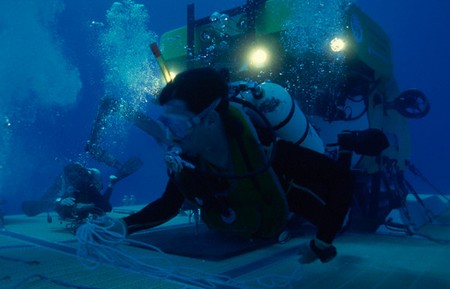One of the thrills of scuba diving is seeing marine life up close. As your diving improves, you will have more time to examine the creatures you encounter and learn more about them.
Coral reefs
It may surprise you to know that most of what you see underwater, especially in tropical areas, is animal life – even the rocks and the foliage. The rocklike parts of coral reefs are made by tiny polyps that leave a calcareous skeleton behind them as they grow. The ‘foliage’ is actually soft coral that becomes tumescent in the current. Both types of coral feed on the minuscule plankton that pass by.
Marine fish
The marine wildlife that you are likely to see includes the little orange fish that flutter around the coral heads in the Indo-Pacific region. They are called anthias. Of the very many different species of anthias, the lyretail anthias are probably the ones you will notice most. Feeding mainly on plankton, anthias hover in groups from about 2 m (6 feet) to 20 m (60 feet) deep.
Divers often encounter jacks. They are fast-swimming predatory fish that range from bar jacks and horse-eye jacks, which form schools of many thousands, to trevallies, which often hunt in small groups.
The largest of all the jacks is the mighty almaco, a deep-bodied amberjack with a dark olive-colored diagonal stripe that stretches from its mouth across the eye to around the dorsal fin.
The almaco jack is found in the Mediterranean, the Atlantic and the Eastern Pacific south of California. It prefers deep, open water away from reefs. Often weighing more than 110 pounds (50 kg) and more than 6 feet (2 m) in length, almaco jacks are magnificent animals.
There are various species of grouper that loiter around the reef. Some are quite small, whereas others are huge. Particularly fascinating, they start life as males and later become females! Napoleon wrasses have an even more complicated sex life. They start life as males, later become females, and when there is a vacancy for a male, one of the females becomes a “super-male.”
Dolphins
Every diver hopes to get close to a pod of wild dolphins. These large, air-breathing mammals live in social groups. There are many species, but the most common are the Atlantic bottlenose dolphin and the Pantropical spotted dolphin.
Special relationships
There are complex symbiotic relationships between some marine animals, such as the shrimp and the goby fish. The goby guards the shrimp’s home, warning it of danger. Both animals benefit – the goby has a safe place to live and the shrimp has an alarm system. The clown or anemone fishes that live within the stinging tentacles of anemones are immune from the stings but are protected by them. Some smaller fish, including gobies, act as cleaners to larger animals, removing parasites from their skin and gills in return for a free meal with no risk of getting eaten themselves.
